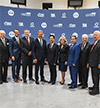Site consultants often have the best view of a state’s performance — especially when compared to other states. They work on a variety of projects in multiple industries, interact with economic development offices, and conduct their own research. They get the hard-to-find details that are needed to select the best site for their client’s requirements. Our 2015 Top States for Doing Business rankings reflect the results of our recent survey asking the consultants to give us their top picks for 21 factors comprising three overall categories — business environment, labor climate, and infrastructure/global access.
Business Environment
Sub-factors for the business environment ranking consist of overall cost of doing business, incentive programs, corporate tax environment, cooperative state government, access to funding, speed of permitting, and most favorable regulatory climate. All these factors work together to create a business-friendly environment that helps companies succeed.
With that in mind, several states have recently overhauled their corporate tax structures. For example, Michigan replaced its Michigan Business Tax with a flat 6 percent rate on corporations that exempts most small businesses. Indiana placed its corporate income tax on a dramatic reduction schedule in 2014, ultimately lowering it to 4.9 percent. In FY 2013, North Carolina had the third-lowest state and local business tax burden in the U.S., according to the Council on State Taxation and EY. As a result of further state tax reforms, the corporate income tax rate fell to 5 percent in 2015 and is expected to drop to 4 percent in 2016. And Texas continues to deliver one the lowest tax burdens in the country according to the Tax Foundation’s 2015 State Business Tax Index. Texas also recently permanently cut its franchise tax by 25 percent, freeing up more business capital for investment.
Providing flexible financial assistance programs is another way to create a healthy business climate and drive long-term economic growth. In California, the state’s Infrastructure and Economic Development Bank (IBank) and the State Treasurer’s Office deploys the most State Small Business Credit Initiative (SSBCI) funds of any state, according to the U.S. Treasury Department. IBank’s Small Business Loan Guarantee Program (SBLGP) has distributed $58 million to guarantee more than $308 million in loans. The two programs have created or retained nearly 40,000 jobs at small businesses since 2011.
In Kentucky, the Kentucky Small Business Credit Initiative (KSBCI) encourages banks to provide capital for entrepreneurs or small businesses. More than $2.4 million in loan support was approved through KSBCI last year, resulting in financial institutions providing $12.8 million in small business loans. Kentucky’s Small Business Innovation Research (SBIR) and Small Business Technology Transfer (STTR) Matching Funds program is recognized as one of the best in the nation — Kentucky businesses have achieved a 50 percent success rate in receiving federal SBIR-STTR grants, compared to the national average of 37 percent.
To remain sustainable, funding programs must be linked to larger-scale responsible fiscal management. For example, according to the Tax Foundation, Tennessee has the lowest state debt per capita in the country, resulting in an AAA credit rating — in fact, its most recent bond sale was at the lowest interest rate ever recorded for that state. Indiana’s balanced budget and fiscal reserves have also rewarded that state with a triple-A bond rating. The state closed FY 2015 with a structural surplus of $210 million. Reserves are the second highest ever in Indiana, at more than $2.14 billion.
A state’s right-to-work (RTW) status is another top consideration for many companies. According to research by the Economic Policy Institute, wages in RTW states are 3.1 percent lower than those in non-RTW states. The AFL-CIO reports an even larger margin: average worker wages in RTW states are 12.2 percent less compared to non-RTW states.
In March 2015, Wisconsin became the 25th right-to-work state in the U.S. The entire southeastern U.S. is right-to-work, which is a strong draw for manufacturers. South Carolina’s and North Carolina’s unionization rate for the private sector is 1.9 percent — one of the lowest in the country. However, RTW vs. non-RTW does not have to be a determining factor in site selection. For example, in Kentucky, a non-RTW state, the union membership rate has never exceeded the national average and, in fact, decreased by 3 percent in 2014. The majority of existing unionized Kentucky facilities are the result of national contracts.
TOP STATES FOR DOING BUSINESS 2015
- 1.Georgia
- 2.Texas
- 3.South Carolina
- 4.Tennessee
- 5.Alabama
- 5T.Florida
- 6.Indiana
- 7.North Carolina
- 8.Louisiana
- 9.Ohio
- 10.Kentucky
Labor is a leading cost for any company. Factors beyond wages and benefits that are considered include availability of skilled workers; effective state workforce development programs that can find and train qualified workers, often at no cost; and postsecondary schools and other educational resources.
A common factor among top-ranked states is a labor force that is supported by a strong network of universities and colleges. For example, Texas’s 146 higher-education institutions awarded more than 271,000 new degrees statewid e in 2013-2014, with many of the graduates entering the Texas workforce. With 457,900 new jobs created in Texas in 2014, these newly graduated professionals will be in high demand for continued job growth.
North Carolina has one of the fastest-growing populations in the U.S., increasing at twice the national rate over the past decade, which helps fulfill workforce needs. More than 380,000 students are seeking degrees at 41 colleges and universities, providing a steady stream of skilled workers.
And in Virginia, more than 575,000 students are enrolled in over 100 in-state institutions of higher education, including 23 community colleges with transferrable programs that partner with companies to offer customized education and training.
Companies now expect to work with state-run workforce development programs that collaborate with universities and colleges to customize workforces for their new or expanded facilities. Two of the most-recognized programs in the country are Georgia Quick Start and readySC, which provide recruiting, screening, and training to fit a company’s needs. Training can be delivered in the classroom, special facilities, or on the plant floor.
For example, employees at Plasma Surgical in Roswell, Ga., make a groundbreaking product used every day in operating rooms. Producing the company’s sophisticated PlasmaJet surgical system requires precision and a great deal of manual dexterity and eye-hand coordination. Since the system was developed in Sweden, many of the processes are new to the Fulton County workforce, though biomedical devices in general are not. To transfer the company’s advanced technology from Europe to Georgia, and to find the best Georgians and train them to manufacture the complex devices, the company partnered with Quick Start. The program’s success in providing customized training for hundreds of advanced manufacturing companies has put Georgia in the top spot for workforce development programs every year since Area Development began this survey of consultants six years ago.
CareerSource Florida provides programs such as quick response training and incumbent worker training to help existing and new companies recruit, train and maintain cutting-edge skills, and keep pace with new technologies.
Last year in Alabama, AIDT — the state’s long-standing workforce development agency — opened the $7 million Alabama Aviation Center at Mobile Aeroplex to help Airbus assemble the workforce for the aerospace company’s newest aircraft assembly facility. AIDT also recently opened a regional training center in Montgomery focusing on manufacturing and IT jobs.
Mississippi has also been highly effective in providing qualified workers for its rapidly growing aerospace industry. Mississippians make a variety of aerospace products, ranging from helicopters and unmanned aerial vehicles to composite jet engine components. Mississippi State University, with its Raspet Flight Research Laboratory and Center for Advanced Vehicular Systems, was recently named an FAA Center of Excellence for unmanned aerial systems. Major aerospace firms operating in Mississippi include Aurora Flight Sciences, Northrop Grumman, and Stark Aerospace. Mississippi is working with its network of 15 community colleges and universities to create customized training programs to meet the needs of its growing aerospace cluster.
Louisiana’s FastStart program was established in 2008 and relies on experienced industry professionals to interface with companies to create highly customized employee recruitment, screening, and training solutions for clients. FastStart constructed a new 65,000-square-foot, advanced training center to support Benteler Steel/Tube’s $975 million manufacturing project in Shreveport. To meet projections of fast job growth in Louisiana over the next five years, FastStart is developing more advanced job-matching and recruitment tools.
Newer workforce development programs include the Kentucky Skills Network, which provided training for 84,000 Kentuckians in a variety of industry sectors in 2014, including manufacturing, healthcare, information technology, energy, distribution, and research and development.
Finally, states also need to look to the future when it comes to STEM (science, technology, engineering, and math) jobs. A widespread problem in manufacturing is not being able to find enough skilled workers to fill openings — especially for STEM-related jobs. Tennessee has become a champion of STEM in K-12 education. In 2013 STEM and STEM-related completions at Tennessee institutions were approximately 28,800, an increase of 31 percent in just five years. Graduates in engineering, engineering technologies, and engineering-related fields have grown in Tennessee by 30 percent from 2008 to 2013.
Indiana has increased its commitment to career and technical education with the goal that by 2020 the state will have a five-fold increase in students who graduate high school with an industry-recognized credential.
In another announcement, Michigan plans to spend $50 million for community college skilled trades equipment, especially for in-demand jobs — one of the largest investments of its kind in the country in 2015.
Consultant's Commentary
Les J. Cranmer, Senior Managing Director; and Art M. Wegfahrt, Corporate Managing Director; Savills-Studley, Inc. T. Bradley Fulkerson III, CCIM, Managing Director, Transwestern Lawrence Moretti, Lfm Corporate Location Solutions Phil Schneider, President, Schneider Consulting LLCWith increasingly global markets, and just-in-time manufacturing and delivery, there has never been greater demand for a modern, well-maintained transportation infrastructure. Our top-ranked states all have well connected interstates and highways, rail lines, airports, and port shipping. Other factors include certified sites/shovel-ready programs, competitive utility rates, energy reliability/smart grids, and water availability/cost.
When combined, all these factors work together to maximize the speed and efficiency of business. For example, Florida’s extensive multimodal transportation system that includes international airports, deepwater shipping ports, and extensive highway and rail networks enables robust economic activity. Merchandise trade valued at $153.2 billion flowed through Florida’s airports and seaports in 2014, making the state one of the world’s leaders in international trade. As a result, many distribution/logistics firms operate in Florida to take advantage of the easy access to global markets.
Port access is critical for global shipping. California has nine deepwater ports within its borders. In 2013, over 17 million intermodal shipping containers moved through California ports. Los Angeles and Long Beach are the two busiest ports in the U.S., moving a combined 14.5 million containers in 2013. In Georgia, the Port of Savannah is the second-busiest seaport for containerized cargo on the East Coast and the fourth-largest and fastest-growing container port in the country.
States also depend on busy inland ports on the Mississippi and Ohio rivers and the Great Lakes. Michigan has access to several major international shipping ports via the Great Lakes. Ohio’s well-integrated transportation infrastructure includes major barge ports on Lake Erie and the Ohio River. In fact, Ohio is eighth in the nation for total water tonnage moved, handling over 103 million tons of cargo valued at $11 billion every year. Memphis is the second-busiest port on the Mississippi River and the fourth-busiest inland port in the U.S. In addition to two deepwater ports on the Gulf of Mexico, Mississippi enjoys robust shipping along the Mississippi River and the Tennessee-Tombigbee Waterway.
It’s not just enough to have the infrastructure — companies also want to see states maintain and improve their transportation networks for the future. At Hartsfield-Jackson Atlanta International Airport — the tenth-largest air cargo hub in North America — plans are under way to add a sixth runway and expand the airport’s air cargo facilities. Charlotte Douglas International Airport in North Carolina will also add a runway and build a new international terminal. The Georgia Ports Authority has committed to $1.4 billion in capital investments for its ports over the next 10 years. Los Angeles and Long Beach ports combined are spending approximately $5 billion on port infrastructure upgrades from 2012 to 2017. The Port of Oakland is in the process of a $1.2 billion upgrade, including building a world-class global trade and logistics center and one million square feet of new warehouse space.
What integrates these different modes of transportation and shipping are intermodal facilities. For many companies, easy access to modern intermodal connections is a must. Ohio, for example, has 10 intermodal facilities that connect its roads, rail, ports, and airports. Texas has two world-class global logistics hubs that support NAFTA trade and provide strategic multimodal transportation access, including an industrial airport, interstates, and an abundance of Class 1 rail lines.
According to the Intermodal Association of North America, intermodal transport is the fastest-growing method of transportation in the U.S. It is more fuel-efficient and creates less pollution. The Port of Mobile in Alabama, one of the nation’s busiest ports, is undergoing a major expansion, including the construction of an intermodal rail facility. Georgia has more than 30 intermodal facilities, most of which are located in Atlanta or near the Port of Savannah. Norfolk Southern has expanded its two intermodal facilities in Atlanta several times and invested over $2 billion in capital improvements to its overall intermodal network. Finally, access to water resources is becoming a serious concern for many companies, especially as drought patterns continue to shift and expand across the country. As surface water dwindles, wells are at more risk for running dry and high-discharge wells for industry are more difficult and expensive to permit. For high water users, long-term access to plentiful water sources is a big deal. This becomes a strong advantage for states like Michigan, Ohio, Wisconsin, and Minnesota along the Great Lakes (which are now at or above normal levels). Other leading states are in the Southeast and the Pacific Northwest, where hydroelectric power plants provide reliable, low-cost electricity to industrial users.



